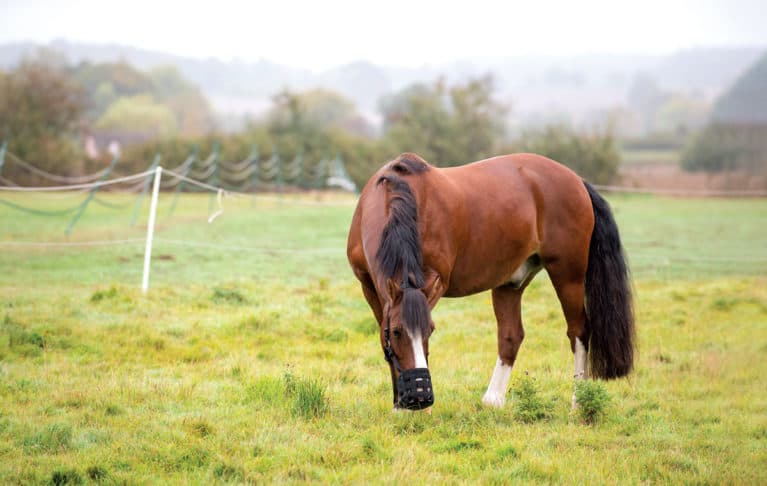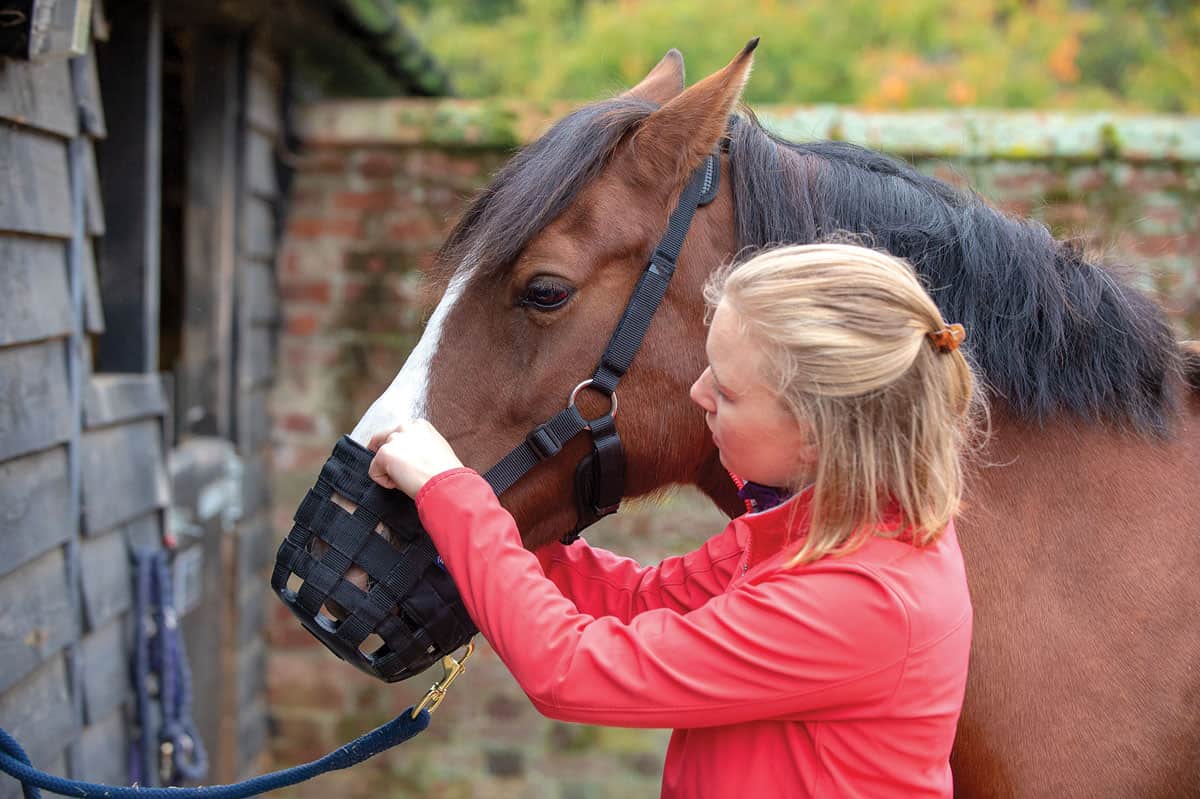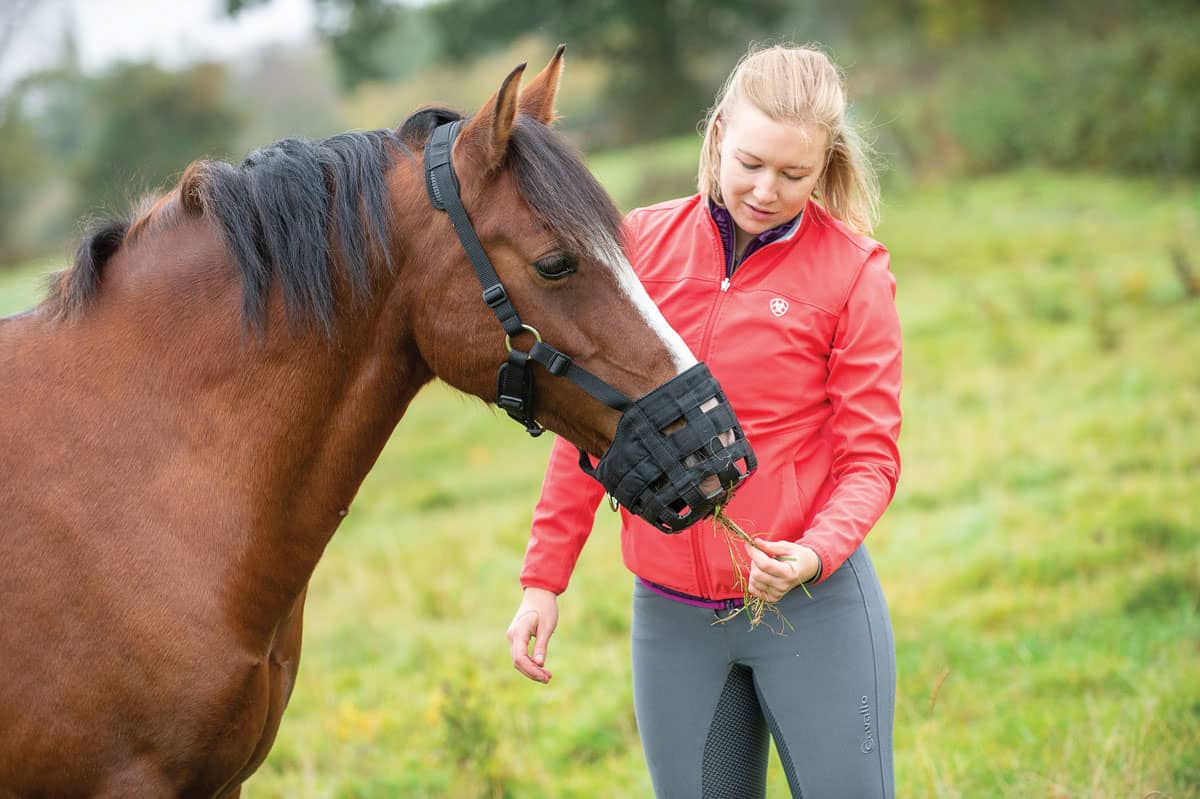Want to restrict your horse’s grass intake without reducing his turnout? Anna Haines shares her grazing muzzle guidance to ensure your horse’s transition to muzzled life is a happy one

Horses are trickle feeders, which means they’ve evolved to spend approximately 16–18 hours eating every day. However, because the fields at most yards are made up of richer types of grass than horses would naturally graze on, weight gain is often an issue.
As the spring grass comes through and horses start to pile on the pounds, many owners find themselves having to restrict their horse’s food intake to keep them healthy. If you’ve ever had to do this, you’ll be familiar with the balancing act that maintaining a healthy body condition score for your horse entails. So, what can be done to improve the situation?
Studies have found that using a grazing muzzle can dramatically reduce a horse’s grass intake, so can be literal life-savers in some cases, although they shouldn’t be used without careful thought and consideration.
Top tip
An ideal scenario is one where a grazing muzzle isn’t required, so monitor your horse’s body condition score regularly and adapt his management accordingly to keep his weight in check.
Essential measures
If you’ve never used one before, a grazing muzzle may look like an extreme course of action to cut down your horse’s grazing, but they can be necessary in some situations where his weight needs to be carefully managed. They’re commonly recommended by vets as a tool to help tackle obesity, particularly in for horses at risk of equine metabolic syndrome (EMS), pituitary pars intermedia dysfunction (PPID) and laminitis.
Did you know?
Using a grazing muzzle may enable your horse to continue natural behaviours in situations where he’d be otherwise stable-bound.
Fit for a king
The correct fit for a grazing muzzle is really important, so it sits comfortably on every part of your horse’s face…
- watch him eating with his muzzle on – it should be easy for him to chew normally while wearing it
- there should be a gap of about 3cm from the end of his mouth to the muzzle
- check him daily for signs of rubbing – common areas include behind his ears, the points of his cheekbones, the top of his muzzle and on his poll
- it should be snug beneath his jaw, but no so much so that it restricts regular chewing
Due diligence
To minimise any potential negative psychological effects, introduce the grazing muzzle gradually and use it appropriately. Simply putting the muzzle on your horse and leaving it on him for a prolonged period is likely to create a negative response, and may lead him to try to avoid having it put on in the future.
Wearing a muzzle needn’t be distressing for your horse – he can still have access to his pasture and social contact with his companions. However, when he wears it, he’ll be unable to carry out important behaviours such as mutual grooming or self-grooming. For this reason, it’s important that he’s allowed time each day when he can be with a companion without the muzzle, in a sparse or bare paddock, so he can still carry out these behaviours.
Positive introductions
To help your horse to develop a positive response towards the grazing muzzle, initially bring it out at the same time as something rewarding, such as some food or a firm scratch on his favourite spot. Once you’re confident he’s started to develop a positive association, introduction can be broken down into small steps…
- Hold the muzzle up for him to look at and reward any positive behaviours towards it, such as looking towards it or reaching out to touch it with his nose.
- Put a small handful of hay or haylage in the muzzle to encourage him to put his nose into it.
- Allow him to eat the food and repeat this multiple times until he wants to immediately put his nose into the muzzle as soon as he sees it.
- When he’s confidently taking hay from inside the muzzle, use strong tape to cover the holes on the bottom and place some smaller items of food into it, such as forage nuts or small pieces of carrot.
- Repeat step three again, but with small food pieces inside the muzzle. This’ll teach him to push against the bottom of the muzzle to get the food.
Top tip
If your horse is on a very restricted diet, try offering him some low-calorie options for treats when introducing the muzzle, such as iceberg lettuce, sugar-free mints or celery.

Herd play
If your horse is turned out wearing his muzzle with companions, spend time observing their interactions to check that their dynamics aren’t negatively affected. This might occur due to his face being partially covered and preventing other horses from being able to see his facial expressions clearly, limiting their subtle behavioural indications.
Safety first
Safety and comfort are of paramount importance when using a grazing muzzle. There are a variety of different styles available and they all fit slightly differently – if you find your horse doesn’t get on with one type, try another design.
Top tip
Clean your muzzle regularly to prevent dirt and debris building up, which increases the likelihood of rubbing.
Over his head
When your horse is totally happy eating out of his muzzle, it’s time to gradually introduce the head strap. Initially do this while he’s eating food out of the muzzle – take the strap up over his head and remove it again without doing it up. This is to gradually introduce him to the fact that the muzzle will be held up by the strap.
If he shows any signs of anxiety at you doing this, repeat this step lots of times, ensuring there’s always food in the muzzle for him to eat, before moving on when he’s showing signs of confidence.
Only fasten the head strap when your horse is totally relaxed. When you initially secure it, do so for just a moment before removing it and rewarding him. Repeat this several times, gradually increasing the length of time that it’s fastened before you remove it.
Learning to graze
Just because your horse has learned to eat out of the muzzle doesn’t mean he’ll understand how to eat through it, so you need to guide him through this process carefully, too. For this step, it’s best to use an old muzzle that you can cut the bottom out of to make a larger hole, so your horse can more readily access food.
Using a headcollar, take your horse out to the paddock and allow him to eat grass through the large hole in the bottom. This will help him learn to push his nose into the muzzle in order to access the grass.
Next, turn him out for a few minutes in this adapted muzzle, while you stand and observe him. Some horses may push their noses along the ground or try to rub the muzzle on something – if they do this for any length of time without stopping to graze, it may be an indication that they’re unhappy or distressed. At this point, it may be necessary to go back to basics and spend more time teaching your horse to get food while wearing the muzzle.
Middle grass
Grass must be an appropriate length – if it’s too short, your horse won’t be able to grasp it with his teeth, but if it’s too long it’ll simply bend over when the muzzle pushes against it. Both of these situations will further limit his access to grazing and could cause immense frustration, which is likely to lead to him developing an aversion to the muzzle.
Top tip
If your horse has a little difficulty getting the grass, drop some forage pellets onto the floor to encourage him to search for food.

The real deal
When your horse starts displaying normal grazing behaviour while wearing the adapted muzzle, see how he reacts to the real thing. When you first put this on him, spend time giving him food through the holes at the bottom so he realises it’s possible to do this.
Next, take him out to his field with it on and allow him to graze in-hand, while monitoring his behaviour. When he appears comfortable, turn him out normally.
Keep an eye out for any indications of discomfort or anxiety from your horse, either when he’s wearing the muzzle or when you approach him to put it on. Signs
to look out for include…
- tension in his face or body
- moving his body or head away from you
- triangulation of his upper eyelid
- raising his head and putting ears back
If you start to notice any of these signs, stop using the muzzle and check carefully for any areas of discomfort. If you can’t find any, reintroduce the muzzle to create a more positive association, or discuss with your vet other options to help your horse lose weight.
Top tip
A grazing muzzle should be worn for a maximum of 12 hours per day, and should never, under any circumstances, be left on for a 24-hour period.
All you can eat
After a period with restricted access to food, your horse may try to make up for lost time when the muzzle comes off. Studies have shown that horses may eat up to two-thirds of their daily intake in just three hours when given free access to pasture following restriction. This is why it’s important to ensure your horse can access some grass while wearing his muzzle, but also to restrict food access when it’s off.
Did you know?
Grazing muzzles aren’t suitable for use on donkeys – their natural behaviour of browsing hedgerows and bushes means they could easily become tangled. They’re also susceptible to developing hyperlipaemia when on heavily restricted diets.
Explore your options
A grazing muzzle is just one, short-term tool that you can use to combat weight gain and obesity. There are lots of other ways that you can help your horse lose weight through management and feeding alterations, changes to his environment and increased exercise. If you’re unsure how to achieve this, speak to your vet, who’ll be able to help you put a bespoke plan together for your horse and the environment he lives in.








